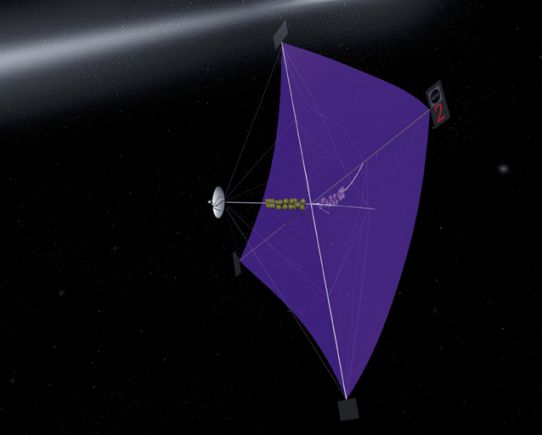Explanation: Nearly 400 years ago astronomer Johannes Kepler observed comet tails blown by a solar breeze and suggested that vessels might likewise navigate through space using appropriately fashioned sails. It is now widely recognized that sunlight does indeed produce a force which moves comet tails and a large, reflective sail could be a practical means of propelling a spacecraft. In fact, the illustration above represents one concept currently being explored by NASA centers to develop an interstellar probe pushed along by sunlight reflected from an ultrathin sail. Nearly half a kilometer wide, the delicate solar sail would be unfurled in space. Continuous pressure from sunlight would ultimately accelerate the craft to speeds about five times higher than possible with conventional rockets -- without requiring any fuel! If launched in 2010 such a probe could overtake Voyager 1, the most distant spacecraft bound for interstellar space, in 2018 going as far in eight years as the Voyager will have journeyed in 41 years.
1999 2000 2001 2002 2003 2004 2005 2006 2007 2008 2009 2010 2011 2012 2013 2014 2015 2016 2017 2018 2019 2020 2021 2022 2023 2024 2025 |
Yanvar' Fevral' Mart Aprel' Mai Iyun' Iyul' Avgust Sentyabr' Oktyabr' Noyabr' Dekabr' |
NASA Web Site Statements, Warnings, and Disclaimers
NASA Official: Jay Norris. Specific rights apply.
A service of: LHEA at NASA / GSFC
& Michigan Tech. U.
|
Publikacii s klyuchevymi slovami:
spacecraft - propulsion - space sail - kepler - kosmicheskie korabli - Solnechnyi parus - Kepler
Publikacii so slovami: spacecraft - propulsion - space sail - kepler - kosmicheskie korabli - Solnechnyi parus - Kepler | |
Sm. takzhe:
Vse publikacii na tu zhe temu >> | |
